Use the following list of choices for the following questions:
I. Helicase
II. DNA Polymerase II
III. Ligase
IV. DNA Polymerase I
V. Primase
Which of the enzymes removes the RNA
nucleotides from the primer and adds equivalent DNA nucleotides to the
3' end of Okazaki fragments?
- V
- III
- I
- IV
- II
d
At a specific area of a chromosome, the sequence of nucleotides below
is present where the chain opens to form a replication fork:
3'
C C T A G G C T G C A
A T C C 5'
An RNA primer is formed starting at the underlined T
(T) of the
template. Which of the following represents the primer sequence?
- 5' A C G U U A G G 3'
- 5' A C G T T A G G 3'
- 5' G C C T A G G 3'
- 3' G C C T A G G 5'
- 5' G C C U A G G 3'
a
Telomerase is an enzyme involved in the replication of the ends of eukaryotic chromosomes.
- True
- False
a
What is a transposable element?
- A viral particle that can excise itself and move from one location to another within or between chromosomes, plasmids, or phage
- Piece of RNA bounded by inverted terminal repeats that can excise itself and move from one location to another within or between chromosomes, plasmids, or phage
- Piece of DNA bounded by inverted terminal repeats that can excise itself and move from one location to another within or between chromosomes, plasmids, or phage
- Piece of a protein that can excise itself and move from one location to another within or between chromosomes, plasmids, or phage
c
Which cluster of terms accurately reflects the nature of DNA replication in prokaryotes?
- fixed point of initiation, bidirectional, semiconservative
- random point of initiation, unidirectional, semiconservative
- fixed point of initiation, bidirectional, conservative
- fixed point of initiation, unidirectional, conservative
- random point of initiation, bidirectional, semiconservative
a
The enzyme telomerase solves the problem of replication at the ends of linear chromosomes by which method?
- causing specific double-strand DNA breaks that result in blunt ends on both strands
- adding a single 5' cap structure that resists degradation by nucleases
- adding numerous GC pairs which resist hydrolysis and maintain chromosome integrity
- causing linear ends of the newly replicated DNA to circularize
- adding numerous short DNA sequences such as TTAGGG, which form a hairpin turn
e
During replication, primase adds a DNA primer to RNA.
- True
- False
b
Which enzyme catalyzes the elongation of a DNA strand in the 5' 3' direction?
- DNA polymerase III
- DNA ligase
- topoisomerase
- primase
- helicase
a
Structures located at the ends of eukaryotic chromosomes are called
- telomerases.
- recessive mutations.
- permissive mutations.
- telomeres.
- centromeres.
d
The leading and the lagging strands differ in that
- the leading strand is synthesized in the same direction as the movement of the replication fork, and the lagging strand is synthesized in the opposite direction.
- the leading strand is synthesized at twice the rate of the lagging strand.
- the lagging strand is synthesized continuously, whereas the leading strand is synthesized in short fragments that are ultimately stitched together.
- the leading strand is synthesized by adding nucleotides to the 3' end of the growing strand, and the lagging strand is synthesized by adding nucleotides to the 5' end.
a
Reverse transcriptase is an enzyme found in association with retroviral activity. It has the property of
- requiring no template.
- translation.
- synthesis of RNA from a DNA template.
- synthesis of DNA from an RNA template.
- most lysozymes.
d
The transforming principle discovered by Griffith is DNA.
- True
- False
b
Avery, et al. (1944) determined that DNA is the genetic material in T2 bacteriophage.
- True
- False
b
In ribose, the 2' C has an OH attached to it.
- True
- False
a
Which of the following are nitrogenous bases of the purine type?
- cytosine and guanine
- uracil and cytosine
- guanine and adenine
- thymine and uracil
- adenine and thymine
c
In his transformation experiments, what did Griffith observe?
- Infecting mice with nonpathogenic strains of bacteria makes them resistant to pathogenic strains.
- Mutant mice were resistant to bacterial infections.
- Mixing a heat-killed pathogenic strain of bacteria with a living nonpathogenic strain can convert some of the living cells into the pathogenic form.
- Mice infected with a pathogenic strain of bacteria can spread the infection to other mice.
- Mixing a heat-killed nonpathogenic strain of bacteria with a living pathogenic strain makes the pathogenic strain nonpathogenic.
c
In RNA, uracil is present instead of thymine (in DNA).
- True
- False
a
In an analysis of the nucleotide composition of double-stranded DNA to see which bases are equivalent in concentration, which of the following would be true?
- A = C
- A + C = G + T
- A = G and C = T and A + C = G + T
- A + T = G + C
- A = G and C = T
b
Deoxyribonuclease is an enzyme which adds 3'-hydroxyl groups to RNA.
- True
- False
b
The basic structure of a nucleotide includes the following components:
- base, sugar, phosphate
- tryptophan and leucine
- mRNA, rRNA, tRNA
- amino acids
- phosphorus and sulfur
a
An Hfr cell can initiate chromosome transfer from one E.coli to another.
- True
- False
a
Lysogeny is a process which occurs during transformation and conjugation.
- True
- False
b
Interrupted mating experiments are used to determine what information?
- levels of DNA homology
- bacterial genome maps
- plasmid DNA nucleotide sequences
- whether a bacterial strain is a prototroph or auxotroph
- virulence of a particular bacterial strain
b
Regarding prokaryotic genetics, which statement is correct?
- Crossing over during prophase I introduces some genetic variation.
- Prokaryotes skip sexual life cycles because their life cycle is too short.
- Prokaryotes feature the union of haploid gametes, as do eukaryotes.
- Mutation is a primary source of variation in prokaryote populations.
- Prokaryotes exchange some of their genes by conjugation, the union of haploid gametes, and transduction.
d
To produce recombinants in bacteria, one crossover is better than two.
- True
- False
b
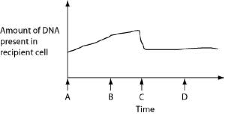
Figure 27.2 depicts changes to the amount of DNA present in a
recipient cell that is engaged in conjugation with an Hfr cell. Hfr
cell DNA begins entering the recipient cell at Time A. Assume that
reciprocal crossing over occurs (in other words, a fragment of the
recipient's chromosome is exchanged for a homologous fragment from the
Hfr cell's DNA). Use Figure 27.2 to answer the following
questions.
Figure 27.2
During
which two times can the recipient accurately be described as
"recombinant" due to the sequence of events portrayed in
Figure 27.2?
- during Times A and C
- during Times C and D
- during Times B and C
- during Times A and B
- during Times B and D
b
Name the general category into which double-stranded circular extrachromosomal DNA elements such as F factors, ColE1, and R would fall.
- plasmid
- capsid
- r-determinant
- partial diploid
- plaque
a
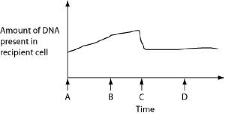
Figure 27.2 depicts changes to the amount of DNA present in a
recipient cell that is engaged in conjugation with an Hfr cell. Hfr
cell DNA begins entering the recipient cell at Time A. Assume that
reciprocal crossing over occurs (in other words, a fragment of the
recipient's chromosome is exchanged for a homologous fragment from the
Hfr cell's DNA). Use Figure 27.2 to answer the following
questions.
Figure 27.2
Which
two processes are responsible for the shape of the curve at
Time B?
1. transduction
2. entry of single-stranded Hfr
DNA
3. rolling circle replication of single-stranded Hfr
DNA
4. activation of DNA pumps in plasma membrane
- 2 and 4
- 1 and 4
- 3 and 4
- 1 and 2
- 2 and 3
e
The transfer of genetic material between bacteria in direct physical contact is called
- transduction
- conjugation
- vertical gene transfer
- transformation
- binary fission
b
This type of recombination does not require homologous sequences and is important for the integration of viral genomes into bacterial chromosomes
- meiotic recombination
- specific recombination/site-specific recombination
- replicative recombination
- vertical recombination
- general recombination
b
Griffith in 1928 conducted an experiment showing that a "transforming principle" from a dead virulent bacterial strain was responsible for converting a live harmless bacterial strain into a virulent one. Later, Avery, MacLeod and McCarthy identified this "transforming principle" to be DNA. What did they use to achieve this?
- Radioactively labeled DNA
- Bacteriophages
- Replica plating
- A U-shaped tube with filter separating the two strains
- Enzymes selectively digesting either protein, DNA or RNA
e
Hershey and Chase used 32P and 35S to label what molecules?
- Protein and RNA, respectively
- Protein and lipids, respectively
- RNA and DNA, respectively
- DNA and protein, respectively
- DNA and RNA, respectively
d
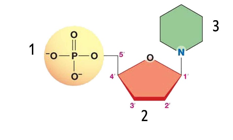
Using illustration below identify the nitrogenous base of a deoxynucleotide:
- 1
- 2
- 3
- 1 and 2 together comprise the nitrogenous base
- 2 and 3 together comprise the nitrogenous base
c
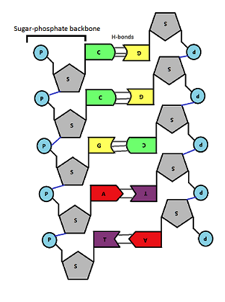
Using following illustration identify the orientation of the DNA strand on the left:
- 5’ end on top
- 3’ end on the bottom
- Impossible to say, not enough information given
- The left strand does not have a direction, only the right strain has a direction and it is 5’à 3’ top to bottom
- This is not a DNA molecule, it is a RNA molecule
a
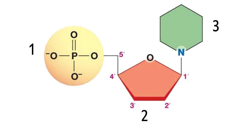
Using illustration below identify a nucleoside:
- 1
- 2
- 3
- 1 and 2 together comprise the nitrogenous base
- 2 and 3 together comprise the nitrogenous base
e
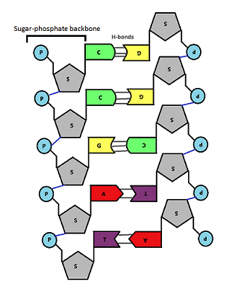
Using the illustration bellow answer the following question. If the left strand acts as a template and the right strain is being newly synthesized, the direction of synthesis would be _____________.
- From top to bottom
- From bottom up
- Impossible to say, not enough information given
- DNA synthesis proceeds in both directions
b
In a DNA strand, what kind of a bond connects two adjacent nucleosides?
- 3’à 5’ phosphodiester bond
- 5’à 3’ phosphodiester bond
- 3’à 5’ nucleoside bond
- 5’à 3’ nucleoside bond
- hydrogen bonds
a
At one point, Watson proposed a model in which like bases paired with like, that is C-C, T-T, G-G and A-A. Why does this model fail to explain the data that was available at the time?
- It violates Chargaff’s rule
- It would not allow for uniform width of the double helix
- It violates rule that says that in any given genome the amount of A=T, C=G
- Two statements are correct
- More than two statements are correct
e
DNA polymerase is a DNA-dependent DNA synthase (uses DNA as a template to produce DNA). Reverse transcriptase is __________________.
- DNA-dependent DNA polymerase
- RNA-dependent DNA polymerase
- RNA-dependent RNA polymerase
- DNA-dependent RNA polymerase
- None of the above
b
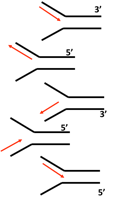
Which one of the following shows the correct orientation of new DNA strain synthesis?
- A
- B
- C
- D
- E
c
Various issues have to be solved during DNA synthesis. One of them is to reduce increased coiling generated during unwinding. Which enzyme is responsible for this?
- helicase
- SSB (single-strand binding protein)
- gyrase
- ligase
- telomerase
c
Various issues have to be solved during DNA synthesis. One of them is covalently linking newly synthesized fragments of DNA. Which enzyme is responsible for this?
- helicase
- SSB (single-strand binding protein)
- gyrase
- ligase
- primase (RNA polymerase)
d
Various issues have to be solved during DNA synthesis. One of them is unwinding of the helix. Which enzyme is responsible for this?
- helicase
- SSB (single-strand binding protein)
- gyrase
- ligase
- primase (RNA polymerase)
a
Various issues have to be solved during DNA synthesis. One of them is to synthesize primers for initiation. Which enzyme is responsible for this?
- helicase
- SSB (single-strand binding protein)
- gyrase
- ligase
- primase (RNA polymerase)
e
At a specific area of a chromosome, the sequence of nucleotides below
is present where the chain opens to form a replication fork: 3' GGC
TAATCGGA
5'
An RNA primer is formed starting at the underlined T of the
template. Which of the following represents the primer sequence?
- 5’ ATTAGCCT 3’
- 5’ AGCC 3’
- 3’ AUUAGCCU 5’
- 3’AGCC 5’
- 5’ AUUAGCCU 3’
e
What is the basis for the difference in how the leading and lagging strands of DNA molecules are synthesized?
- The origins of replication occur only at the 5' end.
- Helicase and single-strand binding proteins work at the 5' end.
- DNA ligase works only in the 3' ----> 5' direction
- Polymerase can work on only one strand at a time.
- DNA polymerase can join new nucleotides only to the 3' end of a growing strand
e
Imagine that you are exposing wild type E. coli cultures to UV in order to produce mutants. How do you screen for lysine auxotrophs (bacteria unable to produce lysine)?
- By growing UV-exposed cultures on complete media
- By growing UV-exposed cultures on minimal media
- By growing UV-exposed cultures on complete media minus lysine
- By growing UV-exposed cultures on complete media, then creating replica plates and grown on complete media minus lysine
- By growing UV-exposed cultures on minimal media with lysine, then creating replica plates grown on complete media minus lysine
d

You conducted an interrupted mating experiment using an E.coli Hfr line and following map was obtained.
Which one of the following maps represents the obtained data:

a
In an Hfr ´ F– mating, if the order of transfer of loci is leu – azi – ton – lac, one can conclude that _____.
- leu is adjacent to lac
- leu is adjacent to the point of origin
- the next transferred locus will be gal
- there are five time units between azi and ton
- all of the above are true
b
In Benzer’s analysis of the many rII mutants of T4 phage which cannot lyse E. coli strain K12, he conducted a complementation test that yielded the following results:
Simultaneous Infection of 2 mutants on E.coli K12
Results (+ = lysis and viruses produced)
Mutants 1, 2 +
Mutants 1, 3 -
Mutants 1, 4 -
Mutants 1, 5 +
Predict the result of the following simultaneous infection:
Mutants 2, 3
- +
- –
- Cannot predict
a
You are trying to replicate Benzer’s experiments with rII mutants of T4 phage which cannot lyse E. coli strain K12, but can lyse strain B. After you conducted a complementation test, you found out that simultaneous infection of K12 cells with mutants 1 and 3 did not produce any plaques (they did no complement). However, simultaneous infection of a B strain followed by infection of K12 strain did produce plaques. What is happening?
- Mutants 1 and 3 do not contain a mutation in the same gene
- Mutants 1 and 3 do contain a mutation in the same gene, but in a different locus
- Impossible to say. Not enough information is given.
- Recombination is inhibited in K12 strain, but still possible in B strain
- Recombination is inhibited in B strain, but still possible in K12 strain
b
Complete the following statement:
During Hfr-mediated conjugation, the recipient ________________.
- May become Hfr
- May become F+
- May become F-
- Never becomes Hfr
- Never becomes F+
d